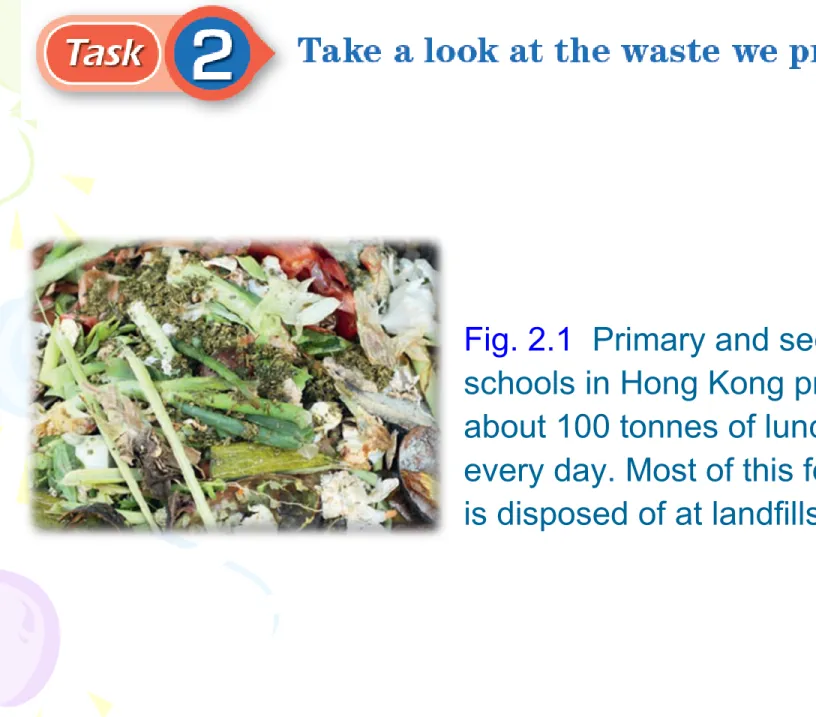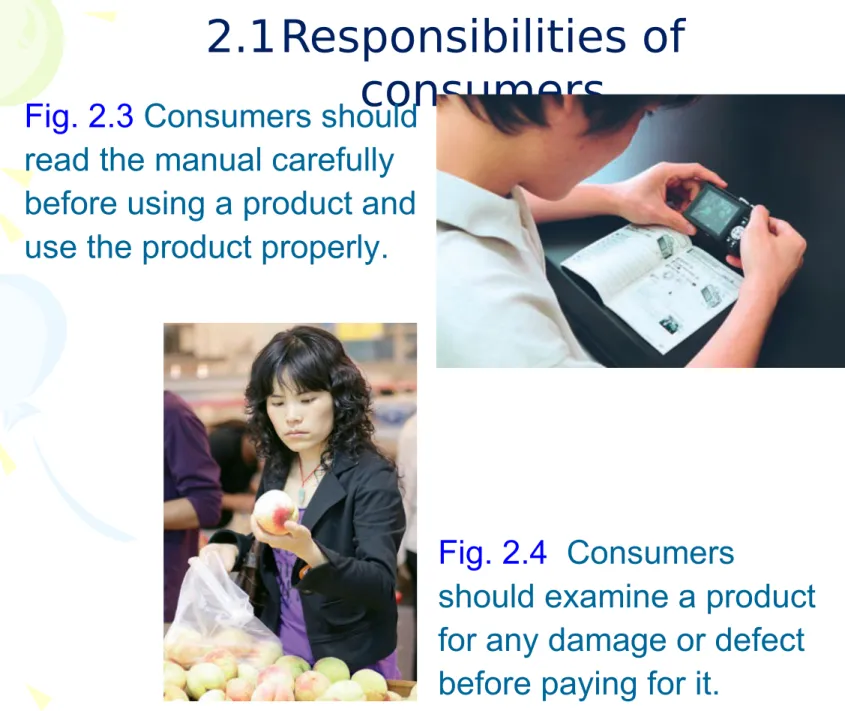Unit
Have the following people fulfilled their responsibilities as consumers? If yes, put a ‘ ’ in the box. Otherwise, put a ‘ ’.
Ms Liu breaks a newly- bought vase accidentally when unwrapping it.
Never mind. I can tell the shopkeeper that it was already broken when
I opened the package. Then I can request an exchange.
Have the following people fulfilled their responsibilities as consumers? If yes, put a ‘ ’ in the box. Otherwise, put a ‘ ’.
The staff of a
telecommunications
company spends an hour introducing various services and explaining contract
terms to Miss Chu.
For me to enjoy the $90 special price, I have to sign up for plans A and B, but they cost $500! I won’t buy either of them.
Have the following people fulfilled their responsibilities as consumers? If yes, put a ‘ ’ in the box. Otherwise, put a ‘ ’.
Mr Wong complains to the Consumer Council that a dried seafood shop has cheated consumers by misleading them about the unit of weight used.
I must complain about this dried seafood shop. They cheated me by stating the price in taels instead of catties!
Have the following people fulfilled their responsibilities as consumers? If yes, put a ‘ ’ in the box. Otherwise, put a ‘ ’.
Mrs Chan plans to buy the cheapest detergent in the household
product shop.
It doesn’t matter if the detergent is environmentally-friendly or not. What matters most is the price. I’ll buy this one.
Fig. 2.1 Primary and secondary schools in Hong Kong produce
about 100 tonnes of lunch leftovers every day. Most of this food waste is disposed of at landfills.
Fig. 2.2 About 70,000 tonnes of electronic waste is generated in Hong Kong every year. Part of this is recycled and the rest is
disposed of at landfills. Electronic waste contains heavy metals such as lead, cadmium and mercury. If it is not treated properly, it will
contaminate the water and endanger our health and the ecosystem.
1. What environmental problem is illustrated by the photos?
Waste disposal problem
(including food waste and electronic waste)
2. How does the above problem relate to the living habits of Hong Kong people?
Many Hong Kong people waste food. They prepare more food than they can eat and have food left over at each meal. These lead to the disposal of a large amount of food waste.
Also, many Hong Kong people love to shop and keep up with the latest fashions. They often buy new clothes and electronic devices. They also choose to buy new goods when old ones break instead of repairing them. This creates a large amount of waste.
3. Suggest ways to reduce lunch leftovers in schools.
Free answers. Suggested answer:
For schools: Canteens can prepare lunch boxes with different portion amounts, so that students can choose the one that suits them.
For parents: Should not prepare too much food for their children in lunch boxes, so as to avoid
wasting food.
For students: Avoid eating snacks before lunch as well as being picky when eating.
1. Be honest.
2. Read the carefully before using a product, and use the product properly according to the instructions.
3. Before making purchases, we should collect relevant inf ormation (e.g., features and prices) and .
similar products and services. We should make consumption decisions .
2.1Responsibilities of consumers
A. Be an honest and wise consumer
manual
compare carefully
4. Examine a product for any or before p aying for it.
5. Before signing the contract, we should read the . carefully and make sure we understand them. If we are not satisfied with the terms, we should to accept them.
2.1Responsibilities of consumers
A. Be an honest and wise consumer
damage defect
terms refuse
2.1Responsibilities of consumers
Fig. 2.3 Consumers should read the manual carefully before using a product and use the product properly.
Fig. 2.4 Consumers
should examine a product for any damage or defect before paying for it.
B. Be responsible to the environment
1. Choose products that cause less harm to the environment (e.
g., products that are ), and products that can be , repaired or upgraded (e.g., rechargeable
batteries).
2. Choose products that are energy-saving and energy-efficient, such as electrical appliances with energy labels.
3. Choose products that have containers or simple wrapping in order to reduce waste.
4. Bring your own when shopping. Use fewer .
5. Separate waste and deposit it into .
6. Make good use of materials in order to reduce wastage.
2.1Responsibilities of consumers
organic recycled
grade 1 refillable
bag plastic bags
recycling bins
2.1Responsibilities of consumers
Fig. 2.5 Choose products that are energy-saving and energy-efficient, such as electrical appliances with grade 1 energy labels. This can help protect the environment.
Fig. 2.6 Consumers should get into the habit of bringing their own shopping bags and using fewer plastic bags.
Practise the 4Rs in our daily life
Recycle: Support
recycling. For example, buy products that are
made from recycled materials and separate
waste for recycling.
Reduce: Buy fewer unnecessary products or products with
excessive wrapping so as to reduce waste.
Replace: Use
environmentally-friendly replacements. For
example, use
handkerchiefs instead of tissues, and take public
transport instead of driving.
Reuse: Make good use of materials to reduce waste. For example, retain empty shampoo bottles and refill
them, or reuse plastic bags.
Practise the 4Rs in our daily life
C. Be responsible to society
1. Respect . Do not photocopy
without authorisation. Refuse to buy . or download songs or movies from the Internet illegally.
2. Do not buy products, as the buying of these products helps promote this . Also, the quality of these products cannot be .
3. If we discover that someone is selling pirated goods or empl oying improper business practices, we should report them to the .
or the .
2.1Responsibilities of consumers
intellectual property rights
books pirated goods
duty-not-paid
illegal activity guaranteed
Hong Kong Customs and Excise Department Consumer Council
The strap is torn because it was mishandled. I won’t refund the money paid.
I bought this backpack from your shop last week. Today I found that one of the straps is damaged. I want a refund.
Study the following cases and answer the questions.
When I signed the contract with your sales representative, I stressed that I wanted to watch all the sports channels. I thought I could watch soccer matches, but only when the season started did I realise that I have to pay an extra fee to watch the English Premier League!
Study the following cases and answer the questions.
Please open the package. I want to examine the baby
carriage before paying. Please pay first and then I’ll let you examine it.
Study the following cases and answer the questions.
I followed the washing instructions when washing this garment with the washing machine, but it still shrank to this size. I want a refund.
Sorry, no refund or exchange after the merchandise has been sold.
Study the following cases and answer the questions.
Discuss whether the consumer in each of the above cases was treated improperly. If yes, point out which of their
consumer rights was infringed.
William was not treated improperly. The shop has a responsibility to exchange goods or provide refunds only if consumers are misled, have bought shoddy goods or have failed to receive satisfactory services.
If the shopkeeper has sufficient reason to believe that the backpack was damaged by William, she has the right to refuse to give him a refund.
Case a:
Discuss whether the consumer in each of the above cases was treated improperly. If yes, point out which of their
consumer rights was infringed.
Case b: Mr Koo was treated improperly. Consumers have the right to obtain sufficient and reliable information
about products and services from manufacturers and suppliers, so as to make sensible consumption
decisions. If the pay-TV company did not explain
clearly to Mr Koo that he needs to pay an extra fee to watch some sports channels, it did not provide
sufficient or reliable information to him. Therefore, Mr Koo’s right to be informed was infringed.
Discuss whether the consumer in each of the above cases was treated improperly. If yes, point out which of their
consumer rights was infringed.
Case c: Mr Wong was not treated improperly. Generally speaking, consumers have the right and
responsibility to examine goods for any damage or defect before paying. However, if consumers decide not to buy some packaged goods after opening their packages, the goods cannot be resold in that
condition. Therefore, the manager has the right to
require Mr Wong to pay before he examines the baby carriage.
Discuss whether the consumer in each of the above cases was treated improperly. If yes, point out which of their
consumer rights was infringed.
Case d: Ms Chow was treated improperly. If she followed the washing instructions but the garment still shrank after washing, the garment was of poor quality.
Consumers who have bought shoddy goods have the right to return the goods and demand a refund.
Therefore, if the shopkeeper refused to refund, Ms Chow’s right to redress was infringed.
2.2Rights of consumers
A. The right to safety
• Manufacturers and suppliers have the responsibility to ensure that products are safe and not hazardous to consumers’ health or life.
• Consumers’ personal data and privacy should be respected and protected. Firms should not release customers’ personal data to other people or institutions without their consent.
2.2Rights of consumers
B. The right to be informed
• Consumers have the right to obtain reliable information about products and services from manufacturers and
suppliers, so as to make sensible consumption decisions.
Fig. 2.8 Consumers have the right to obtain information about food ingredients and nutritional facts.
2.2Rights of consumers
C. The right to choose
• Consumers have the right to select from a range of
products and services which are reasonably priced and of satisfactory quality.
D. The right to redress
• Consumers may be misled, or they may buy shoddy goods or fail to receive satisfactory services.
• In such cases, they have the right to return the goods and demand a refund, or receive a fair settlement of claims and compensation.



